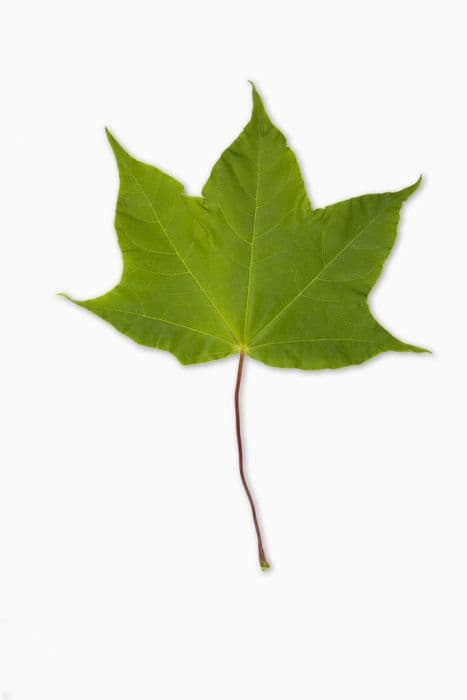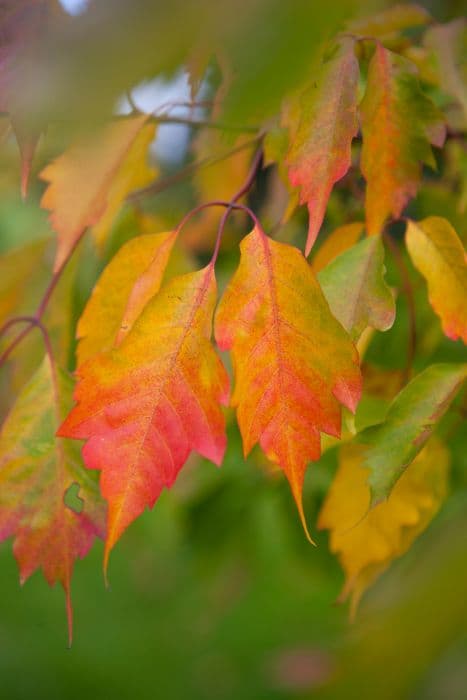Hers Maple Acer grosseri var. hersii

ABOUT
The plant commonly referred to as the Hers's Maple is characterized by its distinctive leaves and overall striking appearance. This plant typically flaunts a lush foliage that presents leaves with a complex shape, often with multiple lobes that give them a somewhat jagged and ornate aspect, reminiscent of the classic maple leaf silhouette. The leaves may display a dynamic range of colors throughout the seasons, shifting from shades of green to a palette of warm autumnal tones such as yellow, orange, and sometimes a deep red that adds a spectacular display to the landscape. The bark of the Hers's Maple is another feature that can draw attention. It varies in texture and can sometimes provide a visual contrast to the softness of the foliage, adding another layer of interest to the plant's overall profile. The spring season usually brings forth flowers, which tend to be small and may not be overly showy but can add a subtle charm to the plant as they blend with the emerging foliage. As the seasons change, the Hers's Maple can produce winged seeds, commonly known as samaras. These seeds are notable for their appearance, which enables them to be carried away by the wind, ensuring the propagation of this maple variety. The seeds have a characteristic shape that is often compared to pairs of wings, allowing them to helicopter away from the parent plant to colonize new areas. Overall, the Hers's Maple is a plant with a rich presence and a visually engaging life cycle that provides year-round interest, with each season accentuating different aspects of its appearance, from the leaf shape and color transformation to the texture of its bark and the particularity of its seeds.
About this plant
 Names
NamesSynonyms
Henry's Maple
Common names
Acer hersii, Acer grosseri var. hersii.
 Toxicity
ToxicityTo humans
Acer grosseri var. hersii is commonly known as the Hers's Maple. There is no well-documented evidence to suggest that this specific variety of maple tree is toxic to humans. Most maples are not known for having poisonous parts, and there are no commonly reported symptoms of poisoning from ingesting parts of this plant. However, as with any plant, individual allergies or sensitivities may exist, and caution should always be exercised when dealing with unfamiliar plant species.
To pets
Hers's Maple (Acer grosseri var. hersii) is not specifically listed as toxic to pets, including dogs and cats. In general, maple trees are not known for being poisonous to pets. However, it is important to note that some other species of maple, such as the Red Maple (Acer rubrum), can be toxic to horses if the leaves are ingested in large quantities. Symptoms in those cases can include abdominal pain and potential red blood cell damage. It is always best to prevent pets from ingesting any plants that are not confirmed to be safe, as individual animals might have different sensitivities or reactions.
 Characteristics
CharacteristicsLife cycle
Perennials
Foliage type
Deciduous
Color of leaves
Green
Height
20-30 feet (6-9 meters)
Spread
20-30 feet (6-9 meters)
Plant type
Tree
Hardiness zones
6
Native area
China
Benefits
 General Benefits
General Benefits- Aesthetic Appeal: Adds ornamental value to gardens with its attractive foliage and architectural form.
- Shade Provider: Can offer shade due to its size and canopy spread once mature.
- Wildlife Habitat: Supports biodiversity by providing a habitat for birds, insects, and small mammals.
- Seasonal Interest: Offers seasonal color changes which can enhance the visual appeal of landscapes throughout the year.
- Erosion Control: Helps prevent soil erosion with its root system, especially on slopes or in areas prone to heavy rains.
- Urban Tolerance: Adapts well to urban environments, dealing with pollution and confined soil spaces better than some other trees.
- Drought Resistance: Once established, shows a degree of resistance to drought conditions.
 Medical Properties
Medical PropertiesThis plant is not used for medical purposes.
 Air-purifying Qualities
Air-purifying QualitiesThis plant is not specifically known for air purifying qualities.
 Other Uses
Other Uses- Acer grosseri var. hersii, commonly known as Hers's Maple, can be used in woodworking to create small decorative objects or intricate veneers thanks to its fine-grained wood.
- The wood of Hers's Maple may also be used in the manufacture of musical instruments, offering a unique appearance and sound to items such as guitars or violins.
- As a natural dye, the bark and leaves of Hers's Maple might be used in textile dyeing to produce varying shades of brown and green.
- Hers's Maple can be planted as part of a natural hedge or living fence, taking advantage of its dense foliage to provide privacy or mark boundaries.
- Leaves from Hers's Maple can be pressed and used in botanical art or to create educational materials for schools or nature studies.
- When dried, the winged seeds (samaras) of Hers's Maple can be used in craft projects or as decorative elements in floral arrangements.
- Young saplings or twigs of Hers's Maple may be cultivated and harvested for use in basket weaving through traditional weaving techniques.
- The tree can serve as a natural sound barrier, with its dense canopy helping to absorb noise pollution in urban or suburban settings.
- Hers's Maple can be incorporated into bonsai cultivation, with enthusiasts shaping and pruning the tree over time to create miniature landscapes.
- The leaves can be used for leaf casting, a process where real leaves are used to create decorative, concrete garden ornaments.
Interesting Facts
 Feng Shui
Feng ShuiThe Snakebark Maple is not used in Feng Shui practice.
 Zodiac Sign Compitability
Zodiac Sign CompitabilityThe Snakebark Maple is not used in astrology practice.
 Plant Symbolism
Plant Symbolism- Strength: Like many trees, Acer grosseri var. hersii, known as the Hers's Maple, symbolizes strength due to its robust wood and enduring nature.
- Resilience: This maple's ability to grow in diverse conditions reflects its resilience, much like the human ability to adapt and survive challenges.
- Beauty: With its attractive bark and foliage, Hers's Maple often represents beauty, appreciating the aesthetics found in the natural world.
- Wisdom: Trees are commonly associated with wisdom, as they live through many years and seasons, potentially making the Hers's Maple a symbol of accumulated knowledge over time.
- Growth: Representing personal growth or development, this plant's gradual increase in size can be seen as a metaphor for life's journey and progress.
 Water
WaterSnake Bark Maple should be watered deeply once a week, providing about 1-1.5 gallons of water per session. During the growing season and hot weather, the frequency may need to increase to twice a week, ensuring the soil remains consistently moist but not waterlogged. During dormant winter months, reduce watering to every other week or less, depending on soil moisture levels. Always check soil moisture at a depth of a few inches to determine if water is needed before the next scheduled watering.
 Light
LightSnake Bark Maple thrives in conditions where it receives partial to full sunlight, ideally about 4-6 hours of direct light daily. Plant it in a spot where it is protected from the harsh afternoon sun to prevent leaf scorch, especially in hotter climates. An ideal position would be one that gets morning sun and afternoon shade or filtered light throughout the day.
 Temperature
TemperatureSnake Bark Maple prefers moderate temperatures and can tolerate a range between 20°F to 80°F, making it versatile in many climates. It is hardy in USDA zones 5 through 7 and should be sheltered from extreme cold and frost below 20°F. The ideal temperature during the growing season ranges from 60°F to 75°F.
 Pruning
PruningPrune the Snake Bark Maple to remove dead or damaged limbs, shape the plant, and encourage healthy growth. This should be done in late winter or early spring while the tree is still dormant, before the sap starts to flow. Light pruning can also be done in summer if necessary, but major cuts are best left for the dormant season.
 Cleaning
CleaningAs needed
 Soil
SoilSnakebark Maple requires well-draining soil with high organic matter content. The ideal pH for Snakebark Maple should range from 5.5 to 7.0. A mix consisting of loam, peat, and pine bark in equal parts makes for suitable soil. Amend with compost to enhance nutrient content and soil structure.
 Repotting
RepottingSnakebark Maples should be repotted every 2 to 3 years, best done in the early spring. Younger plants may require more frequent repotting, whereas mature plants can be repotted less often as their growth rate slows.
 Humidity & Misting
Humidity & MistingSnakebark Maple thrives in moderate to high humidity levels. While it can tolerate lower humidity, maintaining a level around 50-60% is ideal for this species.
 Suitable locations
Suitable locationsIndoor
Place in bright, indirect light; maintain moist soil.
Outdoor
Full sun to partial shade; shelter from strong winds.
Hardiness zone
5-8 USDA
 Life cycle
Life cycleAcer grosseri var. hersii, commonly known as Hers's maple, begins its life cycle as a seed, typically dispersing from the parent tree in the fall. The seed undergoes stratification during the winter, which breaks dormancy and allows for germination in the spring. Upon germination, the seedling emerges and develops its first leaves and a root system to absorb nutrients and water. As the sapling grows, it develops a woody stem and a branching structure, entering a juvenile phase that can last several years. The tree eventually reaches maturity, forming a canopy and producing flowers that, after pollination, develop into winged fruits called samaras. These samaras eventually fall to the ground, starting the cycle anew with the dispersal of seeds.
 Propogation
PropogationPropogation time
Late winter to early spring
The most popular method of propagation for the Acer grosseri var. hersii, commonly known as the Hers's Maple, is by seed. The optimal time for sowing the seeds is in the fall, immediately after they mature. This takes advantage of the natural cold stratification process provided by the winter months, which helps to break the seed's dormancy. To propagate Hers's Maple from seed, collect the samaras (the winged seeds) once they mature in the fall and sow them directly into a prepared seedbed or in pots filled with a well-draining soil mix. Cover the seeds lightly with soil, no more than 1/8 inch (about 3 mm) deep. Keep the soil moist but not waterlogged, and expect germination to occur in the spring as temperatures rise. Seedlings will require care to ensure they are not out-competed by weeds and should be protected from extreme conditions until they are strong enough to be transplanted into their permanent location.








